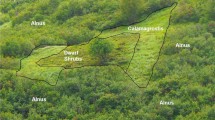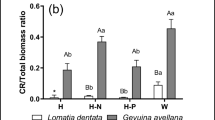Summary
In order to monitor the nitrate assimilation capability of mire plants, in vivo current and maximally induced nitrate reductase activity (NRA) were investigated in 14 species of vascular plants from four different sites in a central Swedish mire. One of the sites was a swamp forest. The plants studied included species with both wide and restricted ecological ranges, and the mire sites selected covered a wide range of plant productivity. At the most productive site, current NRA differed among coexisting species. This differentiation in the use of nitrate as a source of nitrogen suggested the possibility of resource partitioning with regard to nitrogen acquisition. Maximally induced NRA, measured 3 days after an addition of nitrate, was highest at the most productive sites and differed among coexisting species. Plant species characteristic of rich fens had the highest maximally induced NRA. In all species, there was a positive correlation between the ability to assimilate peaks of available nitrate and total leaf nitrogen concentration.
Similar content being viewed by others
References
Aerts R, Berendse F (1988) The effect of increased nutrient availability on vegetation dynamics in wet heathlands. Vegetatio 76:63–69
Aerts R, Berendse F (1989) Above-ground nutrient turnover and net primary production of an evergreen and deciduous species in a heathland ecosystem. J Ecol 77:343–356
Al Gharbi A, Hipkin CR (1984) Studies on nitrate reductase in British angiosperms. I. A comparison of nitrate reductase activity in ruderal, woodland-edge and woody species. New Phytol 97:629–639
Andrews M (1986) The partitioning of nitrate assimilation between root and shoot of higher plants. Plant, Cell and Environment 9:511–519
Begon M, Harper JL, Townsend CR (1986) Ecology. Individuals, Populations and Communities. Blackwell Scientific Publications, Oxford
Carlyle JC (1986) Nitrogen cycling in forested ecosystems. For Abstr 47:307–336
Dirr MA, Barker AN, Maynard DM (1973) Extraction of nitrate reductase from leaves ofEricaceae. Phytochemistry 12:1261–1264
DuRietz GE (1954) Die Mineralbodenwasserzeigergrenze als Grundlage einer natürlichen Zweigliederung der Nord- und Mitteleuropäischen Moore. Vegetatio 5–6:571–585
Gebauer G, Rehder H, Wollenweber B (1988) Nitrate, nitrate reduction and organic nitrogen in plants from different ecological and taxonomic groups of Central Europe. Oecologia 75:371–385
Gutschick VK (1981) Evolved strategies in nitrogen acquisition by plants. Am Nat 118:607–637
Havill DC, Lee JA, Stewart GR (1974) Nitrate utilization by species from acidic and calcareous soils. New Phytol 73:1221–1231
Hultgren ABC (1988) A demographic study of aerial shoots ofCarex rostrata in relation to water level. Aquat Bot 30:81–93
Högberg P, Granström A, Johansson T, Lundmark-Thelin A, Näsholm T (1986) Plant nitrate reductase activity as an indicator of availability of nitrate in forest soils. Can J For Res 16:1165–1169
Högberg P, Johannisson C, Nicklasson H, Högbom L (1990) Shoot nitrate reductase activities of field-layer species in different forest types. I. Preliminary surveys in northern Sweden. Scan J For Res 5:449–456
Koponen T, Isoviita P, Lammes T (1977) The bryophytes of Finland: an annotated checklist. Flora Fennica 6:1–77
Lid J (1985) Norsk, Svensk, Finsk Flora. Det Norske Samlaget, Oslo
Lee JA, Stewart GR (1978) Ecological aspects of nitrogen metabolism. Adv Bot Res 6:1–43
Muller B, Garnier E (1990) Components of relative growth rate and sensitivity to nitrogen availability in annual and perennial species ofBromus. Oecologia 84:513–518
Ohlson M (1986) Reproductive differentiation in aSaxifraga hirculus population along an environmental gradient on a central Swedish mire. Holarct Ecol 9:205–213
Ohlson M (1987) Spatial variation in decomposition rate ofCarex rostrata leaves on a Swedish mire. J Ecol 75:1191–1197
Ohlson M (1988) Variation in tissue element concentration in mire plants over a range of sites. Holarct Ecol 11:267–279
Ohlson M (1990) Dikning av näringsrik sumpskog — ett hot mot våra mest artrika skogsekosystem. Skogsfakta. Flora, fauna, miljö nr 14 (In Swedish, issued by the Swedish University of Agricultural Sciences)
Osborne BA, Whittington WJ (1981) Eco-physiological aspects of inter-specific and seasonal variation in nitrate utilization in the genusAgrostis. New Phytol 87:595–614
Press MC, Lee JA (1982) Nitrate reductase activity ofSphagnum species in the southern Pennines. New Phytol 92:487–494
Sjörs H (1950) Regional studies in North Swedish mire vegetation. Bot Not 1950:173–222
Sjörs H (1952) On the relation between vegetation and electrolytes in North Swedish mire waters. Oikos 2:241–258
Stewart GR, Lee JA, Orebamjo TO (1972) Nitrogen metabolism of halophytes. I. Nitrate reductase activity inSuaeda maritima. New Phytol 71:263–267
Stewart GR, Lee JA, Orebamjo TO (1973) Nitrogen metabolism of halophytes. II. Nitrate availability and utilisation. New Phytol 72:539–546
Tilman D (1977) Resource competition between planktonic algae: an experimental and theoretical approach. Ecology 58:338–348
Tilman D (1982) Resource Competition and Community Structure. Monographs in population biology, Number 17. Princeton University Press, Princeton, New Jersey
Tilton DL (1978) Comparative growth and foliar element concentrations ofLarix laricina over a range of wetlands types in Minnesota. J Ecol 66:499–512
Vitousek PM, Gosz JR, Grier CC, Melillo JM, Reiners WA (1982) A comparative analysis of potential nitrification and nitrate mobility in forest ecosystems. Ecol Monogr 52:155–177
Watt RF, Heinselman ML (1965) Foliar nitrogen and phosporus level related related to site quality in a northern Minnesota spruce bog. Ecology 46:357–360
Wit CT de, Tow PG, Ennik GC (1966) Competition between legumes and grasses. Versl landbouw onderz 687:3–30
Woodin SJ, Press MC, Lee JA (1985) Nitrate reductase activity inSphagnum fuscum in relation to wet deposition of nitrate from the atmosphere. New Phytol 99:381–388
Author information
Authors and Affiliations
Rights and permissions
About this article
Cite this article
Högbom, L., Ohlson, M. Nitrate assimilation in coexisting vascular plants in mire and swamp forest habitats in Central Sweden. Oecologia 87, 495–499 (1991). https://doi.org/10.1007/BF00320411
Received:
Accepted:
Issue Date:
DOI: https://doi.org/10.1007/BF00320411




